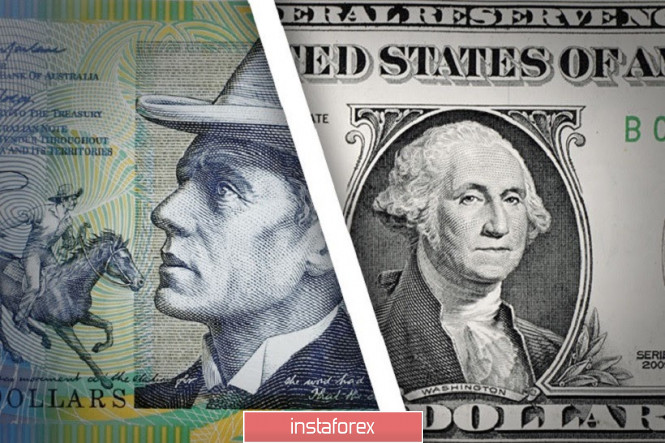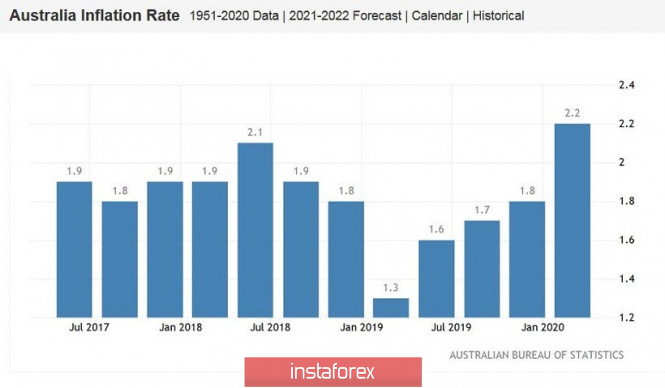The AUD/USD pair ignored the greenback's decline from yesterday, which was caused by profit-taking on the last day of April and the Federal Reserve's unexpected decision to expand the lending program. But the aussie did not become the beneficiary of the current situation – it retreated from positions it won against the greenback, although it steadily strengthened for almost two weeks, reaching a one-and-a-half-month price high of 0.6571. The long-term intentions of buyers of AUD/USD are obvious – to return the pair above the 70th mark, that is, to the range of 0.70–0.73, within which the pair was trading for many months before the coronavirus crisis.
In general, the fundamental background contributes to the aussie's growth - primarily due to a decrease in the spread of COVID-19, due to the easing of restrictive measures in China and Australia, and an unexpected increase in Australian inflation in the first quarter. While the excitement around the US currency has significantly decreased, the Fed is pumping markets with liquidity, demonstrating softness in conducting monetary policy. All this suggests that the Reserve Bank of Australia at its next meeting (which will be held on May 5, that is, next Tuesday) will take a wait-and-see position, and perhaps hint at an interest rate increase in the second half of the year.

Such hopes are primarily due to the unexpected increase in Australian inflation in the first quarter of this year. The data published earlier this week came out in the green zone, surprising market participants. In annual terms, the consumer price index increased for three quarters - from the second quarter of 2019, approaching the target two-percent mark (1.8%) at the end of 2019. Taking into account recent events, most experts expected a decline in inflation at the beginning of this year due to a significant decrease in consumer activity. But contrary to all expectations, the CPI crossed the 2 percent mark on an annual basis and reached 2.2%. In quarterly terms, the indicator decreased, but again, it turned out to be better than forecasts (a decline to 0.3% with a forecast of 0.1%). Moreover, core inflation showed positive dynamics, rising both in monthly and annual terms. By the way, the latest data on the labor market in Australia also came out better than forecasts – instead of an increase in unemployment to 5.4%, the indicator rose to 5.2%; instead of a decline in the number of employed to -30 thousand, the indicator grew to almost 6,000. But there is one caveat: these figures reflect only the first two weeks of March, while strict quarantine was introduced in the country in the second half of the month before last.
Meanwhile, investors were also pleased with the latest data on Australia's foreign trade: in March, the volume of exports of goods increased by 29% on a monthly basis, primarily due to growth in the commodity sector. In particular, iron ore exports to China recovered after a significant decline in the first months of this year.
Therefore, the aussie's growth is primarily due to two factors – first, national macro indicators show a decline that was not as strong as expected (and sometimes show growth), and secondly, China has come out of lockdown, launching its economy. China, as you know, is the largest trading partner of Australia, so this factor has played such an important role for the aussie. In addition, the Australian authorities are also gradually relaxing the quarantine regime, returning to normal life.
All this suggests that next week, members of the RBA could express cautious optimism about the recovery of the national economy in the second half of the year. It is obvious that the regulator will keep the current parameters of monetary policy in the same form, but it will not frighten the market with additional measures. A wait-and-see position will support the aussie, especially against the background of the vulnerability of the US currency.

Let me remind you that yesterday the Fed unexpectedly (just the day after the April meeting) announced an expansion of the scale of the lending program for small and medium-sized businesses. The program itself was announced three weeks ago, but changes have been made only now - "after receiving feedback from more than two thousand companies and individuals." First, the regulator lowered the minimum amount for loans of certain categories from 1 million to 500 thousand dollars, second, it increased the list of companies that can get loans under this program, and third, it created a new option with an increase in the share of risk from lenders for borrowers with a higher ratio of equity and debt. This unexpected move came as a surprise to dollar bulls, after which the dollar index significantly slumped, reflecting a decline in demand for the greenback across the market.
Thus, the AUD/USD pair retains the potential for further growth. The current decline in prices is explained by negative data from China – the April PMI for the manufacturing sector came out slightly worse than expected (50.8 instead of 51). But, firstly, the indicator remained above the key 50-point level, and secondly – we are talking about April, when the country was just leaving the strict quarantine regime. Therefore, this fundamental factor will have a temporary impact. In the medium-term perspective, you can consider long positions with a growth target of 0.6590 (the upper line of the Bollinger Bands indicator on the daily chart).
The material has been provided by InstaForex Company - www.instaforex.com